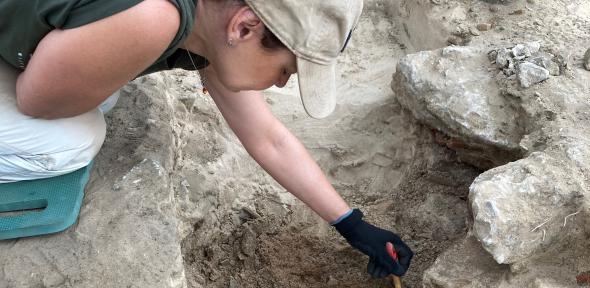Institute of Continuing Education (ICE)

Submitted by Amy Kingham on Thu, 23/06/2022 - 22:52
In spring of this year, ICE’s Academic Director in Archaeology, Dr Gilly Carr, led a rare opportunity to excavate at a former Nazi concentration camp, taking two current ICE students along with her.
Ravensbrück was the largest women’s concentration camp in the German Reich – of more than 140,000 people imprisoned there during the second World War, over 85% were women and girls drawn from 30 countries, including the United Kingdom. Prisoners were put to work in slave labour facilities in and around the camp, and thousands of women were shot, gassed or killed through malnutrition, violence and brutality in the camp, or medical experiments between 1939 and 1945.
Today, the site hosts the Ravensbrück Memorial. Eighty kilometres north of Berlin, the Memorial includes a large museum dedicated to the camp’s history, as well as several exhibitions and commemorations spread across the buildings and grounds. After speaking at a Memorial conference in 2019, Dr Carr first discussed excavating at the site with the Memorial’s former director, and was given an invitation to return.
“I contacted my colleague at the University of Vienna, Professor Claudia Theune, who I’d worked with before,” explains Gilly. “Claudia has excavated at many former concentration camps, so it was great that she was able to be a co-director of the project.” In addition to Claudia and the Memorial itself, the fourth project partner was the Brandenburgisches Landesamt für Denkmalpflege (Brandenburg State Office for the Preservation of Monuments).
Claudia Theune and Gilly Carr also invited two students from their respective institutions, with learners from ICE’s Undergraduate Diploma in Conflict Archaeology and Heritage joining the week-long excavation. “The past academic year was the first time we’d offered this Diploma, and it’s a course I’ve wanted to design and teach for a long time,” says Gilly. “I was thrilled to be able to give places on the excavation to two students, and it was very appropriate to have an all-female team digging at a former women’s concentration camp.”
One of the invited students, Sarah Holloway, recalls her excitement at being asked to join the team: “I’ve been an amateur archaeologist for many years, working towards a degree in archaeology, so this was an incredible opportunity. I’d never visited a camp before, so I was keen to learn as much as I could about Ravensbrück, particularly in terms of the challenge of respectfully and sensitively memorialising a place where so much pain and suffering occurred.”
However, with the visit soon to begin, the team were presented with a last-minute problem. “We originally had plans to survey the Siemens & Halske forced-labour workshops next to the concentration camp,” notes Gilly. “But because of the risk of unexploded ordinance, that wasn’t possible. So the Memorial staff drew our attention to an aerial photograph of the camp taken in 1944 that shows a building of unknown function which no longer survives, and they gave us permission to excavate there instead.
“Together, the six of us dug a 20m trench 80cm wide. It was hard, heavy work. We mostly found demolition debris of one of the camp buildings, but on the last day we realised that the archaeology in our trench was much deeper than anticipated. We cut five slices across the trench and revealed, in one place, a large amount of corroded iron machinery, including a nameplate for a company in Rotterdam. We’re still investigating what the company may have supplied, but the find raises important questions about the nature of collaboration between civilian society in the Netherlands and the Nazis.”
For Sarah, the project took on both personal and cultural significance: “The Memorial staff were so warm, welcoming and appreciative of our work. It was nice to think that we were able to contribute in some way towards understanding the story of the site.
“And, for me, spending time learning from such knowledgeable and respected academics while experiencing first hand an excavation at a former second World War concentration camp was an amazing experience.”
“Excavating at a concentration camp is an honour and a privilege,” agrees Gilly. “On the dig, we spent the week talking and thinking about the people who suffered and died there, and in the evenings, we spent time researching the testimonies of survivors. In a way, our work is another form of memorial, intended to draw attention to those victims and tell their stories.”
And, adds Gilly, it’s work that is not complete: “It’s purely a question of securing funding. The Ravensbrück Memorial staff have invited us, and I would love to go back with ICE students once again.”